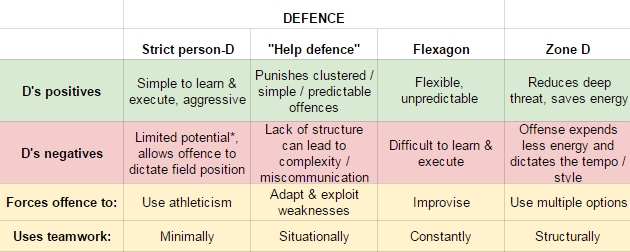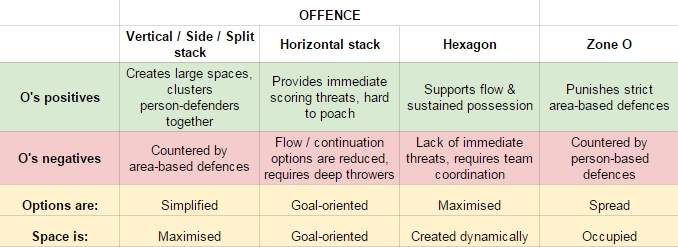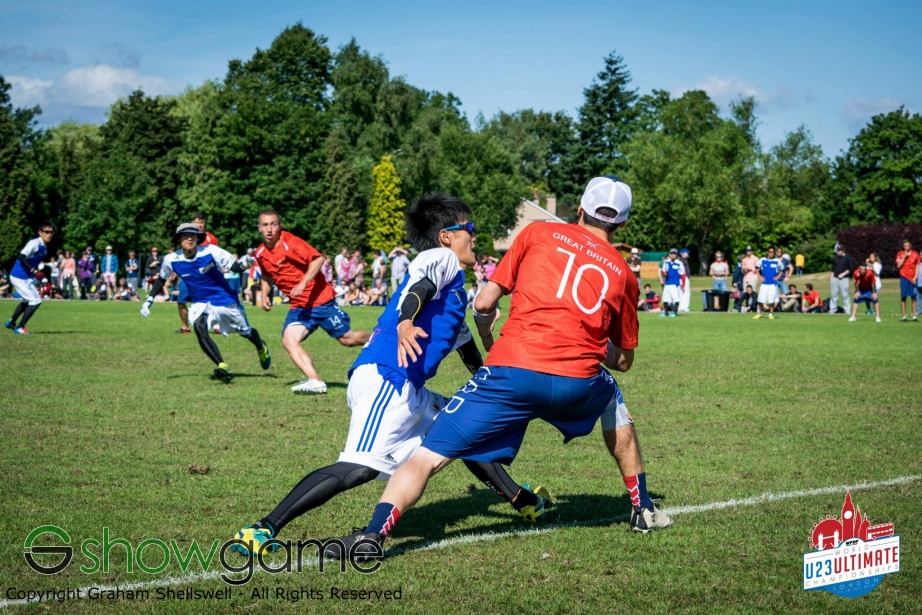In this article I will be seeing how a selection of common offences match up to a selection of common defences in Ultimate, and whether any conclusions can be drawn about the most effective offences / defences for teams to spend time learning in order to efficiently counter their opponents’. When planning what strategies your team should learn in any given season, it’s important to know what their strengths and weaknesses are, and how they are most likely to be countered effectively by your opponents.
The strategies listed are by no means exhaustive – every strategy has several different ways of being played, several tweaks or modifications, several patterns or plays which can be employed – none of which are touched on here, for the sake of simplicity. Environmental factors are not considered, “match-strategy” is not considered (e.g. come out more aggressive at the start of a match; change your defence regularly), skill-sets of teams or individual players are not considered, and different teams will have experienced different levels of success with the strategies listed – these estimates and statements are generalisations, made in order to achieve some kind of tangible comparison between the offensive/defensive strategies based on their merits and drawbacks.
I’m working with four offences and four defences:
Vertical / side / split stack offence: Players line up in the centre or at the side of the field, and make hard ‘cuts’ to the space available, before ‘clearing’ back into a stack. One player stays behind the disc as a dump/reset.
Horizontal stack: Players create a 3-4 formation (3 backfield, 4 downfield), with the downfield players either cutting towards or away from the disc.
Hexagon offence: Players form a hexagon made from equilateral triangles, often in a 2-3-2 formation, with movement creating space for passes in any direction. More info on Hex offence here.
Zone O: Varies from team to team, but usually 3 or 4 players in the backfield, who swing the disc from side to side, looking to pass downfield to ‘poppers’ attacking the space in front of the disc, and wings or deeps further downfield.
Strict person-D: Each defender marks an offensive player, staying very close to them for the duration of the offence. The side the defender tries to hold position on their mark is determined by the direction of the force put on the thrower.
“Help-defence”: A modification of person-D where the defenders are heads-up to switching marks and helping covering dangerous space when appropriate. More info on Help-defence here.
Flexagon: A hybrid defence, taking elements from person-D and Zone, to apply pressure to all players by using constant teamwork and communication. In theory a 2-3-2 setup, but actual positioning is entirely dependant upon where the offensive players are. More info on Flexagon D here.
Zone D: Defenders spread over the field to cover the space, usually overloading the area in front of the thrower to limit short downfield throwing options. There are many types of Zone D, this article does not distinguishing between them (for simplicity).

* a note about strict person-D: although much pressure can be applied by playing this defence with smart local positioning and trained athletic moves, I see the strategy as limited due to (a) the absence of teamwork between downfield defenders, and (b) the over-reliance upon matching or surpassing your opponents athletically.

The table below compares each offence against each defence. The numbers are scoring likelihood / defence likelihood estimates, assuming two high-to-elite level teams are competing with well-practiced offences vs well-practiced defences. For example, assume the (very common) combination of Vertical stack vs strict person-D would see the offence scoring without turning over 85% of the time – use this as calibration for the other numbers, whether or not you agree with the figure! This is roughly the same for Horizontal stack vs person-D, and for Zone O vs Zone D – these combinations are generally considered comparable with each other in terms of effectiveness, as they are the most commonly played.
“Help-defence” is more variable than the others, as it depends a lot on how well it is played by the defence, and how well the offence adapts – so I’ve given the numbers a range.
Hexagon and Flexagon are quite new strategies, so the estimates are more likely to be inaccurate, however they are taken from 2-3 years of regularly teaching and playing the strategies – including with the GB U23 Mixed 2015 team.
All the numbers are rough estimates of likelihood, and the relative effectiveness of each strategy will certainly vary from team to team, and depending on how each is played!

vs Strict person-D, it’s best to get defenders clumping together (covering the least / most useless space), so a vertical or side stack is ideal, and horizontal creates a large deep space. Hex spreads the defenders out, meaning the D actually becomes more efficient.
vs “Help-defence”, defenders who are clumping together will be able to poach/switch to help each other, so vertical stack becomes less effective. Horizontal spreads the defenders well, making it hard for them to help each other effectively – especially when it comes to covering the immediate deep threat. Hex spreads the defenders further and punishes poaching more efficiently, but doesn’t offer the immediate deep threat of Horizontal.
vs Flexagon, vertical stack is negated, and Zone O doesn’t function well due to the tight marking against static players. Any set cutting patterns of plays are unlikely to work, so Horizontal stack and Hexagon must improvise in order to function. Improvisation is easiest done when the number of available options is maximised, so Hex is the ideal setup.
vs Zone D, stack offences are negated. Zone O and Hex have both been shown to be effective at breaking down area-based (zonal) defences, so should be played to counter Zone D.
vs Vertical / Side / Split stack offences, the offensive players are clumping, so strict person-D plays to their strength (clumping your defenders together and leaving large open spaces), whilst Zone or Flex will force them to transition into another offence. Help-defence punishes the clumping, which encourages the offence to improvise, and can generate turnovers when played well.
vs Horizontal stack, the offence is more spread, so help-defence is harder to implement. Strict person-D is moderately effective as usual (depending on your athleticism vs theirs), but Zone D or Flexagon will force the offence out of any pattern- or play-based movement.
vs Hexagon, simple person-D can cause issues, specifically if you are more athletic than your opponents. Help-defence is easier punished by Hex than other offences, but can force the offence to use all their options. Traditional zones don’t change the formation of the Hex, but can force a different play-style which the offence may not be used to. Flexagon applies pressure to the highest number of options, forcing the offence to improvise – meaning any set patterns or plays become unreliable, and players must identify space for cuts and passes as and when they appear.
vs Zone-O, the offensive players are looking for space to occupy, so person-D will force a transition. Zone D conserves the energy of most defenders, however Zone O will be well-practiced against Zone D. Flexagon is more person-focussed, which forces Zone O either to transition or to improvise – to play at a different pace/tempo than they are used to in Zone O.
From an offence point of view: The most common defence is strict person-D, and the most common offence – vertical stack – does well to exploit strict person-D’s weaknesses. If the defence start switching and poaching (“Help-defence”), then the offence must start to improvise, and would ideally be able to counter with a practiced Horizontal stack or Hexagon offence. If facing Flexagon, offensive improvisation from a Horizontal / Hex / Zone O setup is necessary. If the defence play Zone, then the offence must respond with a practiced Zone O or Hexagon offence.
From a defence point of view: The most common offence is vertical stack, which plays to the weaknesses of strict person-D. Playing Flexagon or a Zone D will force the offence to transition – and you will see if they have a practiced alternative. Zone O can be countered effectively with person-D or Flexagon, which forces the offence to either completely improvise, or to play Horizontal stack or Hexagon offence. Flexagon still functions well against these offences, as does person-D – providing there is no athletic disadvantage.
From an offence point of view: Time spent perfecting a vertical stack offence can be made to be ineffective if a defence plays anything other than strict person-D. Training an offence which works against Zone (i.e. Zone O or Hexagon offence) is essential. If your opponents have good “Help-defence” or Flexagon D, then you must either be able to improvise, or transition to Horizontal / Hexagon in order to keep your scoring percentages up. Horizontal must transition when facing Zone, but Hexagon can be played effectively against any defence you face – even though it may not necessarily be the most effective against any defence individually. Your team can function against any defence if they know both Horizontal (with improvisation) and Zone O, or if they simply know Hexagon offence. To be the most effective, a team should also learn an offence which punishes strict person-D more efficiently – vertical- or side-stack.
From a defence point of view: Strict person defence is simple to learn and functions against any offence, but its success is determined by the athletic edge you have over the opponent, and limited by the lack of teamwork involved. If you have an athletic edge over almost every opponent then strict person-D can get enough turns to win games, but only until you reach an athletically superior team playing a well-practiced offence, or until your own offence is countered. Learning a more challenging defence, particularly one which counters the most common offence – vertical stack – is essential, unless you are fully relying on your athleticism or your offence.
“Help-defence” is hard to learn and implement due to its lack of structure and principles, and it is most useful against vertical stack – less so against Horizontal or Hex. Zone D completely counters vertical and other stack offences, however most teams have a well practiced Zone O which will counter it well. Although Flexagon is also hard to learn, it is flexible enough to be played effectively against any offence you face, countering the most common vertical stack and Zone offences effectively.
More info on Hex offence here.
More info on Help-defence here.
More info on Flexagon D here.
Video of Flexagon D in action.








